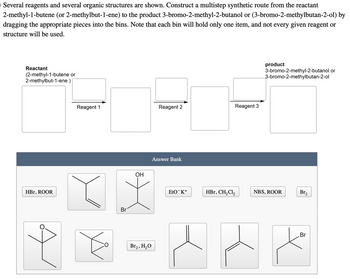
Organic Chemistry
8th Edition
ISBN: 9781305580350
Author: William H. Brown, Brent L. Iverson, Eric Anslyn, Christopher S. Foote
Publisher: Cengage Learning
expand_more
expand_more
format_list_bulleted
Question
HELP NOW PLEASE ! URGENT!

Transcribed Image Text:o Several reagents and several organic structures are shown. Construct a multistep synthetic route from the reactant
2-methyl-1-butene (or 2-methylbut-1-ene) to the product 3-bromo-2-methyl-2-butanol or (3-bromo-2-methylbutan-2-ol) by
dragging the appropriate pieces into the bins. Note that each bin will hold only one item, and not every given reagent or
structure will be used.
Reactant
(2-methyl-1-butene or
2-methylbut-1-ene):
HBr, ROOR
Reagent 1
Reagent 2
Reagent 3
Br
OH
Br₂, H₂O
Answer Bank
product
3-bromo-2-methyl-2-butanol or
3-bromo-2-methylbutan-2-ol
EtO-K+
HBr, CH2Cl2
NBS, ROOR
Br₂
Br
Expert Solution
This question has been solved!
Explore an expertly crafted, step-by-step solution for a thorough understanding of key concepts.
Step by stepSolved in 2 steps with 1 images

Knowledge Booster
Similar questions
- What is the mechanism to get from the reactant to the productsarrow_forwardHeck reactions take place with alkynes as well as alkenes. The following conversion involves an intramolecular Heck reaction followed by an intermolecular Heck. Work out the reaction sequence on a separate sheet of paper, and then draw the structure of the palladium-containing intermediate A. 1% mol Pd(OAc)₂2 CO₂Me 4% mol Ph P CH₂CN A (1 ring) C (2 rings) (2 rings) • Consider E/Z stereochemistry of alkenes. • You do not have to explicitly draw H atoms. • Do not include lone pairs in your answer. They will not be considered in the grading. • Use R1 to represent the palladium complex. The R group tool is located in the charges and lone pairs drop-down menu. 0- ✪ Sn [F MeO₂Carrow_forwardPlease help me with the mechanism with arrows.arrow_forward
- Provide an arrow pushing mechanism for the following transformation. Draw out a representation of the transition-state in the rate-determining step.arrow_forwardThe following reaction involves two sequential Heck reactions. Draw structural formu- las for each organopalladium intermediate formed in the sequence and show how the final product is formed. Note from the molecular formula given under each structural formula that this conversion corresponds to a loss of H and I from the starting material. Acetonitrile, CH,CN, is the solvent. 1% mol Pd(OAc), 4% mol Ph,P CH,CN C4H171 C4H16arrow_forwardIn each reaction box, place the best reagent and conditions from the list below. 1) 2) 3) 4) H2O Br2, hv CH3CH2MGBR CH3CH2CU (CH3CH2)2CuLi Br2, NaOH CH3LI CH3CH2CULI Pyridine PBr3 CH3CH2LI (CH3CH2)2Cu CH3MGBR (CH3)2CuLi Br2, H30*arrow_forward
- . Provide the reagents necessary to carry out the following conversion. OH u NaOH/H₂O 1. NaOCH3, 2. H₂O¹ 1. (CH₁) COK, 2. BH3, 3. H₂O/NaOH/H₂O | 1.(CH3)COK, 2. HOarrow_forwardFf.144.arrow_forwardМЕСНANISMS 1,2-epoxy-1-methylcyclopentane undergoes both acid-catalyzed and base-catalyzed opening of the epoxide ring to form two different products. > Using ethanol as the solvent and an appropriate acid, show the steps in the acid catalyzed mechanism, writing structures for all products of the steps. Circle the major product(s). > Using ethanol as the solvent and an appropriate base, show the steps in the base- catalyzed mechanism, writing structures for all products of the steps. Circle the major product(s). 1,2-epoxy-1-methylcyclopentane CH3arrow_forward
- In each case below select the synthetic procedure that could be used to carry out the transformation shown. The procedures are: Epoxidation/hydrolysis: alkene + meta-chloroperoxybenzoic acid; then H₂O*. OsO4 oxidation: alkene + OsO4; then NaHSO3 CH₂CH3 Submit Answer CHCH3 HO Retry Entire Group OH CH₂CH3 OH -CHCH3 OH 1 more group attempt epoxidation/hydrolysis Os04 oxidation both methods neither method 126arrow_forward1) Draw the complete electron-pushing arrow mechanism for the following reductions. Explain, using resonance contributors (structures), the regiochemistry that results in each case. OMe Na, MeOH ? NH3 CHO Na, MeOH ? NH3arrow_forwardHW7 #8arrow_forward
arrow_back_ios
SEE MORE QUESTIONS
arrow_forward_ios
Recommended textbooks for you
 Organic ChemistryChemistryISBN:9781305580350Author:William H. Brown, Brent L. Iverson, Eric Anslyn, Christopher S. FootePublisher:Cengage Learning
Organic ChemistryChemistryISBN:9781305580350Author:William H. Brown, Brent L. Iverson, Eric Anslyn, Christopher S. FootePublisher:Cengage Learning Organic Chemistry: A Guided InquiryChemistryISBN:9780618974122Author:Andrei StraumanisPublisher:Cengage Learning
Organic Chemistry: A Guided InquiryChemistryISBN:9780618974122Author:Andrei StraumanisPublisher:Cengage Learning

Organic Chemistry
Chemistry
ISBN:9781305580350
Author:William H. Brown, Brent L. Iverson, Eric Anslyn, Christopher S. Foote
Publisher:Cengage Learning

Organic Chemistry: A Guided Inquiry
Chemistry
ISBN:9780618974122
Author:Andrei Straumanis
Publisher:Cengage Learning
